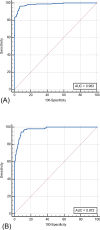Automated deep learning-based bone mineral density assessment for opportunistic osteoporosis screening using various CT protocols with multi-vendor scanners
- PMID: 39443535
- PMCID: PMC11499650
- DOI: 10.1038/s41598-024-73709-w
Automated deep learning-based bone mineral density assessment for opportunistic osteoporosis screening using various CT protocols with multi-vendor scanners
Abstract
This retrospective study examined the diagnostic efficacy of automated deep learning-based bone mineral density (DL-BMD) measurements for osteoporosis screening using 422 CT datasets from four vendors in two medical centers, encompassing 159 chest, 156 abdominal, and 107 lumbar spine datasets. DL-BMD values on L1 and L2 vertebral bodies were compared with manual BMD (m-BMD) measurements using Pearson's correlation and intraclass correlation coefficients. Strong agreement was found between m-BMD and DL-BMD in total CT scans (r = 0.953, p < 0.001). The diagnostic performance of DL-BMD was assessed using receiver operating characteristic analysis for osteoporosis and low BMD by dual-energy x-ray absorptiometry (DXA) and m-BMD. Compared to DXA, DL-BMD demonstrated an AUC of 0.790 (95% CI 0.733-0.839) for low BMD and 0.769 (95% CI 0.710-0.820) for osteoporosis, with sensitivity, specificity, and accuracy of 80.8% (95% CI 74.2-86.3%), 56.3% (95% CI 43.4-68.6%), and 74.3% (95% CI 68.3-79.7%) for low BMD and 65.4% (95% CI 50.9-78.0%), 70.9% (95% CI 63.8-77.3%), and 69.7% (95% CI 63.5-75.4%) for osteoporosis, respectively. Compared to m-BMD, DL-BMD showed an AUC of 0.983 (95% CI 0.973-0.993) for low BMD and 0.972 (95% CI 0.958-0.987) for osteoporosis, with sensitivity, specificity, and accuracy of 97.3% (95% CI 94.5-98.9%), 85.2% (95% CI 78.8-90.3%), and 92.7% (95% CI 89.7-95.0%) for low BMD and 94.4% (95% CI 88.3-97.9%), 89.5% (95% CI 85.6-92.7%), and 90.8% (95% CI 87.6-93.4%) for osteoporosis, respectively. The DL-based method can provide accurate and reliable BMD assessments across diverse CT protocols and scanners.
Keywords: Bone density; Deep learning; Osteoporosis; Tomography; X-Ray computed.
© 2024. The Author(s).
Conflict of interest statement
The authors declare no competing interests.
Figures




Similar articles
-
Evaluation of deep learning-based quantitative computed tomography for opportunistic osteoporosis screening.Sci Rep. 2024 Jan 5;14(1):363. doi: 10.1038/s41598-023-45824-7. Sci Rep. 2024. PMID: 38182616 Free PMC article.
-
Prediction of bone mineral density from computed tomography: application of deep learning with a convolutional neural network.Eur Radiol. 2020 Jun;30(6):3549-3557. doi: 10.1007/s00330-020-06677-0. Epub 2020 Feb 14. Eur Radiol. 2020. PMID: 32060712
-
End-to-End Semi-Supervised Opportunistic Osteoporosis Screening Using Computed Tomography.Endocrinol Metab (Seoul). 2024 Jun;39(3):500-510. doi: 10.3803/EnM.2023.1860. Epub 2024 May 9. Endocrinol Metab (Seoul). 2024. PMID: 38721637 Free PMC article.
-
Efficacy of Hounsfield Units Measured by Lumbar Computer Tomography on Bone Density Assessment: A Systematic Review.Spine (Phila Pa 1976). 2022 May 1;47(9):702-710. doi: 10.1097/BRS.0000000000004211. Epub 2021 Aug 30. Spine (Phila Pa 1976). 2022. PMID: 34468433
-
Computed Tomography Measured Psoas Cross Sectional Area Is Associated With Bone Mineral Density Measured by Dual Energy X-Ray Absorptiometry.J Clin Densitom. 2022 Oct-Dec;25(4):592-598. doi: 10.1016/j.jocd.2022.04.001. Epub 2022 Apr 29. J Clin Densitom. 2022. PMID: 35606278 Review.
Cited by
-
A comparative study of bone density in elderly people measured with AI and QCT.Front Artif Intell. 2025 Jul 23;8:1582960. doi: 10.3389/frai.2025.1582960. eCollection 2025. Front Artif Intell. 2025. PMID: 40771941 Free PMC article.
References
-
- Wolterink, J. M. et al. Automatic coronary artery calcium scoring in cardiac CT angiography using paired convolutional neural networks. Med. Image Anal. 34, 123–136. 10.1016/j.media.2016.04.004 (2016). - PubMed
MeSH terms
Grants and funding
- 20010927/The Ministry of Trade, Industry & Energy (MOTIE, Korea)
- NTIS#1415169348/The Ministry of Trade, Industry & Energy (MOTIE, Korea)
- S2844049/the Ministry of Small and Medium-sized Enterprises (SMEs) and Startups (MSS, Korea)
- NTIS #1425142385/the Ministry of Small and Medium-sized Enterprises (SMEs) and Startups (MSS, Korea)
LinkOut - more resources
Full Text Sources
Medical

